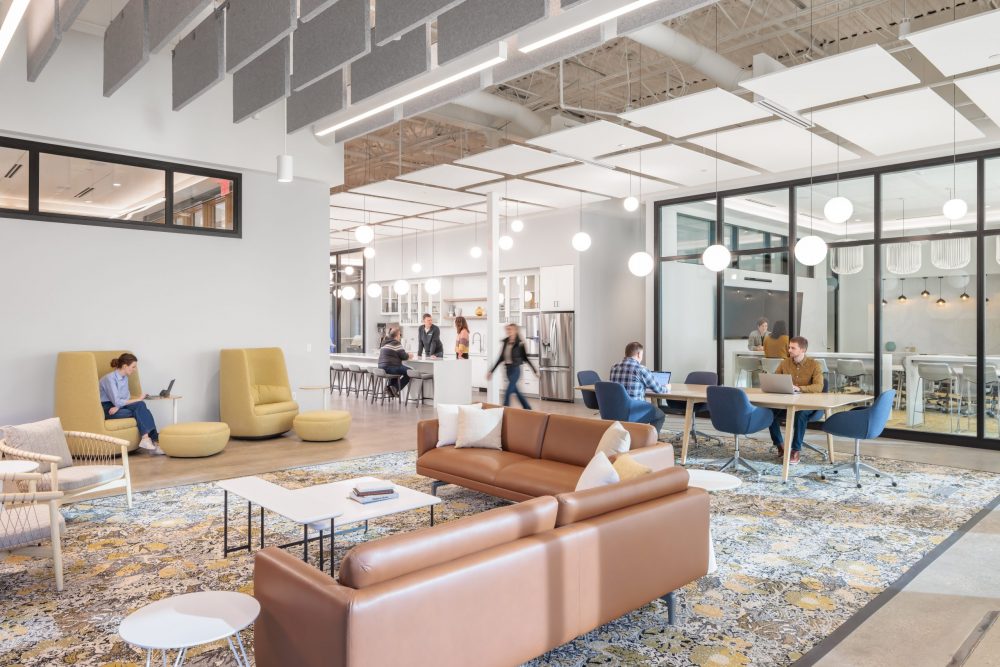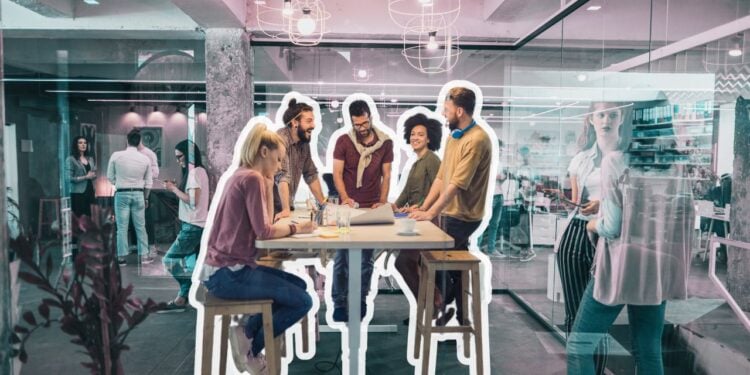- A culture of optimism can lead to a thriving and successful organization, and the design of the workplace offers the platform to create that culture.
- Optimism in the workplace can be fostered through human-centered design focusing on employee well-being, process support, and social connectivity, with elements like adaptable workspaces, biophilic design, and advanced technology.
- Creating a sense of community through flexible, collaborative spaces and ensuring remote workers are included can significantly contribute to a culture of optimism and a thriving organizational environment.
This article was written by Ashley Macaulay and David Little from HGA for Work Design Magazine.
In an increasingly hybrid office climate, employers are testing new ways to spur engagement, innovation and optimism through the physical workspace and its relation to employees’ home offices.
The home office has several benefits for employees and employers alike, but without meaningful connection to other employees and the company at-large, it’s difficult for employees to maintain the sense of belonging that contributes to a positive outlook on their work and the greater impact it makes.
As designers, we realize the workplace itself serves a distinct purpose for each company and, when designed with intention, it can be a source for company-wide optimism.
When deciding whether or not to come into the office, we’ve found that employees are more motivated to make the commute if:
- They know others will be there as well;
- They need to schedule in-person team collaboration or educational experiences;
- They are provided technology or resources that they need and that their home offices do not have; or
- They are offered a “respite from home” with diverse and unique environments that meet or exceed their home comforts and amenities

Employees will come to the office more often and stay longer if they have similar access to the benefits of the home office, including autonomy, choice and the ability to move around throughout the day based on task and work mode.
When employees are motivated to come into the office, employers will find it’s easier to ignite optimism in a controlled environment reflective of their company’s values and supportive of their employees’ work processes.
Defining Workplace Optimism
When determining the best way to generate a positive outlook in the workplace, it’s important to set goals that specifically address optimism.
Formally defined, optimism is an individual’s expectancy of positive outcomes; in the workplace, that can lead to confidence in one’s abilities, positive attitudes toward workplace challenges and a renewed focus on growth and improvement—all of which also benefit companies.
Formally defined, optimism is an individual’s expectancy of positive outcomes; in the workplace, that can lead to confidence in one’s abilities, positive attitudes toward workplace challenges and a renewed focus on growth and improvement.
A human-centered design approach can be the key that unlocks optimism and encourages employees to use the office and its resources.
In the case of Marvin’s reimagined Eagan, Minnesota office, HGA worked closely with leadership to create an office built around a sense of community, collaboration and well-being that fully supports company culture and employees’ new ways of working. Specific goals the Marvin team set in conjunction with HGA were:
- Developing a master plan that shifted the office layout from department-owned spaces to flexible, cross-disciplinary environments;
- Identifying employees’ preliminary new way of working (hybrid), and how they now prefer to structure their workdays;
- Investigating the effectiveness of larger collaboration and project rooms as well as more intimate, enclosed spaces for meetings;
- Evaluating how focus and rejuvenation spaces are understood by employees; and
- Using a “Changemaker” approach to engage Eagan users and co-design around their expertise and insights to support personal comfort and optimal work.
When optimism is thriving at a company, leadership may see effects including increased productivity and performance, improved job satisfaction and retention, enhanced collaboration, better problem solving and reduced stress or burnout. In order to achieve these goals, workplace environments and the cultures that they inherently foster must be thoughtfully considered.
In the case of Marvin, HGA implemented three methods for determining the unique mix of strategies and spaces the company needed in the Eagan office. This included distributing a questionnaire that surveyed all employees in the office to evaluate their aspirations and motivations to return to the office and how those had changed from pre-pandemic through post-pandemic flex work.
Additionally, HGA hosted “Changemaker” workshops with a representative sample of employees to gather insights, define challenges and prioritize needs as well as ideate and co-create solutions.
Finally, the design team conducted a thorough building and program analysis that comprised an assessment of the existing Marvin space, a program spreadsheet of current and future growth and a working modality policy based on future frequency of working in the office to inform the resulting program.
Design Strategies that Foster Optimism
Once the information gathering stages have concluded, we find it’s helpful to organize design strategies into three of the primary contributing factors for fostering optimism: employee well-being, work process support and social connectivity.
Employee Well-being
Employee well-being can be supported through a variety of means, all of which can contribute significantly to overall optimism. One key method is ensuring physical comfort rooted in controllability and choice, including everything from lighting and temperature controls to operable scenic doors for accessible fresh air.
Choice can also be delivered in the form of employee autonomy with offerings such as diverse spaces that support various working modalities, including third spaces and break areas for respite.
In-office choice can also be supported by home-like additions such as Marvin’s fireplace area or furnishings to support work-from-home behaviors like sitting cross-legged and using footstools or lounge chairs.

Perhaps the most optimistic design strategy of all is helping employees see beyond the workday to the outside and greater community at-large, and a clear connection to nature can help with that.
This connection can be drawn through biophilic design elements like daylighting, access to outdoor environments, greenery and bringing the outdoors inside. In the case of Marvin, HGA incorporated indoor pergolas with live planters used as space dividers.
Installed on the building exterior is the Marvin “Skycove,” a projected glass structure that provides a link to the outdoors for those lounging inside—a great amenity for Minnesota winters. Even room names throughout the office locate themselves relative to Minnesota bodies of water, another nod to the world outside.
A change of scenery with spaces that emanate the brand and spark inspiration and creativity for employees to do their best work can also support employee well-being. For Marvin, recognizable yellow rose iconography from the brand’s logo is thoughtfully referenced through abstract wall coverings, art and pops of yellow. The overarching bright and airy feel is signature to Marvin spaces. Marvin products are also incorporated throughout the office to connect the quality and aesthetics of the brand to employees’ day-to-day work, creating a sense of pride in knowing the work done in the office is a part of something special.
Work Process Support
It’s also important to ensure that employees have the tools and resources to optimistically approach their unique work processes. Supporting the hybrid workday is integral to this, including providing spaces that seamlessly connect collaborative, in-person modes with virtual modes of working as well as spaces that support different types of collaboration—from formal presentations to casual conversations. Advanced technology is also foundational to fully equipping employees to do their best work.
For Marvin, in-office “Workshops” took form as highly scalable spaces that could flex from small meeting, large conference, project room or presentation layouts to an open employee engagement space. Any version of these spaces is now reservable for up to a week to support the storage of a team’s in-process work mid-project. Additionally, Workshops surrounded by Marvin products connect users to the possibilities of the brand, fostering further ideation and innovation.
Sense of Community
Ultimately, a sense of community is a primary contributor to developing cultural optimism, and it’s something that’s hard to replicate in the work-from-home setting. It’s a key factor for individuals deciding if and when to come into the office and can be supported by a variety of design strategies. For Marvin, Workshops and spaces for sharing were pivotal to supporting their collaborative culture, including project and department storytelling.
A sense of community is a primary contributor to developing cultural optimism, and it’s something that’s hard to replicate in the work-from-home setting.
Communal spaces integrated as a part of the primary circulation path, such as Marvin’s centralized work cafe, can help to foster critical informal connections that build a flexible work culture.
The design of various spaces and their supportive technology can and should help employees to know who is in the office and if they’re available for team collaboration. Community-focused design strategies should also not ignore the needs of remote workers, and equitable technology should be integrated to ensure they feel included with those who are in-office.
A culture of optimism can lead to a thriving and successful organization, and the design of the workplace offers the platform to create that culture.
It’s important that employees feel valued as people, and not just workers, and all of the above mentioned design strategies support this sentiment. In the case of Marvin, the company is already seeing the positive effects and lively buzz that the new Eagan office now has. Employees are owning the optimistic culture that the space has given them the platform to create, and that’s the best result we can hope for as designers.


 Dr. Gleb Tsipursky – The Office Whisperer
Dr. Gleb Tsipursky – The Office Whisperer Nirit Cohen – WorkFutures
Nirit Cohen – WorkFutures Angela Howard – Culture Expert
Angela Howard – Culture Expert Drew Jones – Design & Innovation
Drew Jones – Design & Innovation Jonathan Price – CRE & Flex Expert
Jonathan Price – CRE & Flex Expert














